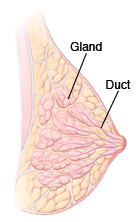A lump was found in your breast. Most breast lumps are not cancer. They may be caused by normal changes in the breast tissue due to hormone variations that occur with your menstrual cycle. Some women may form lumps that are painful and tender. Others may form lumps that are painless.
At this time, it's not possible to know what caused your lump without further evaluation. This could include:
-
Another exam by your healthcare provider or a gynecologist
-
Imaging tests, such as a mammogram or ultrasound
-
Biopsy (procedure to remove small tissue samples from the breast lump)
Your healthcare provider will explain any additional testing that is needed. Be sure to get answers to any questions you may have.
Home care
Until a diagnosis is made, you may be advised to do the following:
-
If you are having breast pain:
-
Take an over-the-counter pain reliever, if directed to by your healthcare provider.
-
Wear a well-fitted bra or sports bra for extra support. If you have breast pain at night, try wearing the bra during sleep.
-
Apply a warm compress (towel soaked in warm water) to the breast. You may also use a hot water bottle.
-
-
Check your breasts each day. Keep a log of whether the lump seems to be changing in size or tenderness with your period. This can help your healthcare provider make the correct diagnosis.
Follow-up care
Follow up with your healthcare provider as directed. Keep all appointments. Also, get ready for any upcoming tests as directed.
When to get medical advice
Call your healthcare provider right away if any of these occur:
-
Fever of 100.4°F (38°C) or higher, or as directed
-
Redness or swelling of the breast
-
Discharge from the nipple
-
Visible changes in the skin over the nipple or breast
-
Lump grows larger, feels very hard, or has an irregular shape
-
New lumps form
Featured in


